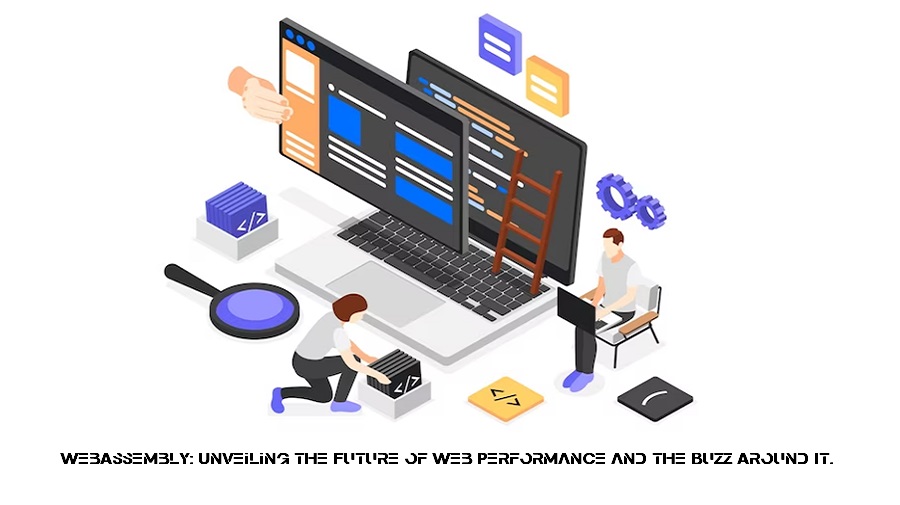WebAssembly: Unveiling the Future of Web Performance and the Buzz Around It.

Within the dynamic and perpetually evolving expanse of web development, the relentless pursuit of swifter and more optimized web applications stands as an unwavering aspiration. The contemporary user populace, ever so discerning and accustomed to seamlessness, fuels the impetus for this ceaseless endeavor. As the chorus of users echoes the resonance of flawless experiences, the community of developers ardently endeavors to orchestrate a harmonious symphony that satiates these cravings.
In this unceasing odyssey, WebAssembly emerges as a phoenix from the flames, a technology that heralds an era of innovation with the potential to fundamentally reshape the very tapestry of web performance. It is within this landscape that the contours of this article gracefully unfurl—a literary journey that delves unfathomable depths into the embrace of WebAssembly, embarking upon an exploratory sojourn that lays bare its pivotal role in not merely augmenting web performance but also heralding a paradigm shift in the tides of technological evolution. As the confluence of aspiration and innovation surges forward, the advent of Top Class Else Arttech Web Development Service signifies a harmonious alliance that propels this narrative further into the annals of cutting-edge progress.
The Need for Speed: Web Performance Matters
————————————
The contemporary denizens of the digital realm have seamlessly embraced the ethos of instant gratification as an unwavering norm. The sluggish cadence of websites and applications unfurling at a leisurely pace, however, emerges as a proverbial thorn in the side of these very users. The ramifications extend beyond mere frustration, as the latency-riddled landscape invariably ushers forth elevated bounce rates—a testament to the sway wielded by expeditious access.
Hence, the canvas of web performance has seamlessly transitioned into a theater where each interaction garners newfound significance within the overarching narrative of user engagement and their unabated pursuit of satisfaction. A riveting evolution is palpable, as the symphony of websites undergoes a metamorphosis, donning the attire of complexity and dynamism. However, a noteworthy dichotomy unveils itself; the traditional vanguards of web technologies, exemplified by the revered JavaScript, occasionally grapple to extend the responsive embrace that the users ardently seek.
Introducing WebAssembly: A Game-Changer in Performance
————————————
WebAssembly, conveniently abbreviated as Wasm, emerges on the digital horizon as a beacon of unparalleled promise, illuminating the pathway toward elevated web performance. However, the imperative query that beckons forth is the essence of WebAssembly itself. In a distilled narrative, WebAssembly unfurls as an intricately woven binary instruction format, a tapestry of computational directives that browsers possess the innate acumen to unravel with alacrity, verging upon the realms of native execution velocity.
This transformative facet signifies that the fraternity of developers is now endowed with the prerogative to harness an array of programming languages including the likes of C, C++, and Rust. Within this newfound panorama, they are primed to eloquently inscribe code that seamlessly resonates with the web’s fabric of functionality. The very act of transmuting these languages into the enigmatic realm of WebAssembly engenders an expeditious journey toward surmounting the hitherto recognized confines imposed by the performance limitations intrinsic to the traditional, albeit venerable, realm of JavaScript.
Bridging the Gap: How WebAssembly Enhances Performance
————————————
The magic of WebAssembly lies in its ability to accelerate performance-intensive tasks. Consider scenarios like complex calculations, data processing, or even running entire applications within the browser. These tasks often strain the capabilities of traditional JavaScript. WebAssembly steps in here, transforming these tasks into seamless and swift operations.
The key to WebAssembly’s performance boost lies in its bytecode format. Unlike human-readable code, WebAssembly’s bytecode is compact and optimized for quick transmission and execution. When a user accesses a website that incorporates WebAssembly, the browser fetches the bytecode and compiles it into machine code. The result is a significant reduction in load times and a noticeable enhancement in user experience.
WebAssembly in Action: Real-World Applications
————————————
It is of significant import to emphasize that WebAssembly does not harbor intentions of supplanting JavaScript. Instead, these two formidable technologies are poised to coalesce seamlessly, working in unison to yield outcomes of unparalleled optimization. Within this dynamic ecosystem, JavaScript retains its paramount role as the preferred choice for steering user interfaces, orchestrating DOM manipulations, and undertaking tasks of a distinctly browser-centric nature. Conversely, the forte of WebAssembly unfurls in the realm of undertaking computationally demanding operations, showcasing its prowess in resource-intensive computations that demand heightened efficiency.
Envision a scenario wherein a web-based game comes to fruition. Within this intricate orchestration, JavaScript emerges as the steward of user interactions and the custodian of UI elements. Concurrently, WebAssembly ascends as the driving force behind the game’s physics engine, wielding its prowess to deliver an amalgamation of rapidity and interactivity that forms the bedrock of a holistic user experience. The symbiotic fusion of these technologies births an ecosystem wherein developers harness the unique virtues of both realms, ingeniously crafting an experience that resonates with unparalleled seamlessness and dynamism.
WebAssembly and JavaScript: A Dynamic Duo
————————————
It is of significant import to emphasize that WebAssembly does not harbor intentions of supplanting JavaScript. Instead, these two formidable technologies are poised to coalesce seamlessly, working in unison to yield outcomes of unparalleled optimization. Within this dynamic ecosystem, JavaScript retains its paramount role as the preferred choice for steering user interfaces, orchestrating DOM manipulations, and undertaking tasks of a distinctly browser-centric nature. Conversely, the forte of WebAssembly unfurls in the realm of undertaking computationally demanding operations, showcasing its prowess in resource-intensive computations that demand heightened efficiency.
Envision a scenario wherein a web-based game comes to fruition. Within this intricate orchestration, JavaScript emerges as the steward of user interactions and the custodian of UI elements. Concurrently, WebAssembly ascends as the driving force behind the game’s physics engine, wielding its prowess to deliver an amalgamation of rapidity and interactivity that forms the bedrock of a holistic user experience. The symbiotic fusion of these technologies births an ecosystem wherein developers harness the unique virtues of both realms, ingeniously crafting an experience that resonates with unparalleled seamlessness and dynamism.
The Excitement and Potential of WebAssembly
————————————
The excitement and anticipation surrounding WebAssembly are profoundly tangible. Its remarkable capability to serve as a bridge between native applications and the expansive realm of the web has undeniably flung open doors to a rich tapestry of novel possibilities. Yet, the fervor encompassing WebAssembly transcends the realm of sheer velocity. Its inherent compatibility with an array of diverse programming languages elegantly forges pathways toward the invaluable realms of code reuse and seamless migration. In practice, this signifies that developers are empowered to adeptly port their existing codebases from languages like C++ and Rust, a strategic maneuver that not only conserves time but also streamlines their diligent efforts.
However, amid its journey of triumphs, WebAssembly is not without its fair share of trials. Presently, it grapples with a minor limitation—the absence of direct access to the venerable Document Object Model (DOM). Consequently, the judicious utilization of JavaScript becomes a prerequisite for facilitating interactions with the pivotal elements nestled within web pages. Moreover, owing to the inherently low-level nature of WebAssembly, there arises a necessity for meticulous memory management. This necessity, while fostering a remarkable degree of control, might potentially engender intricacies within the codebase, thereby potentially paving a path toward the emergence of security vulnerabilities that warrant scrupulous vigilance.
Looking Ahead: The Future of WebAssembly
————————————
As the web development community continues to actively explore and wholeheartedly embrace the realm of WebAssembly, its trajectory is undeniably promising. This technology is in a state of rapid evolution, characterized by continuous and dynamic efforts aimed at augmenting its performance capabilities, broadening its language compatibility, and honing its tooling infrastructure. This ongoing evolution not only paves the way for enhanced web experiences but also unlocks new horizons that span from the immersive landscapes of virtual reality experiences to the intricate realms of sophisticated data processing, all seamlessly executed directly within the confines of the web browser.
Elseart Tech Software development continues to gain traction and becomes increasingly pervasive within the web development landscape, it is poised to catalyze a cascade of further advancements. The proliferation of WebAssembly is likely to serve as a catalyst for the innovation of cutting-edge debugging tools, ingenious performance optimization techniques, and even more seamless integrations with a diverse array of web technologies. This collaborative and forward-looking spirit ensures that WebAssembly sustains and augments its momentum, further establishing itself as an undeniable transformative force reshaping the very fabric of the world of web development.
Conclusion:
In conclusion, WebAssembly is more than just a buzzword; it’s a game-changer in the world of web performance. Its ability to accelerate execution and deliver near-native speeds has ignited excitement and driven innovation. WebAssembly’s role in the future of web development is undeniable, promising a more efficient, responsive, and feature-rich online experience for users across the globe. As the web continues to evolve, WebAssembly stands as a testament to the relentless pursuit of better web performance and the boundless possibilities it unlocks.




